Picture this: You’re wandering in the wild African forests, surrounded by tall trees and animal noises filling the air. Suddenly, you spot something colorful moving through the leaves – it’s an amazing African Bush Viper! It’s got these cool patterns and a pointy head that makes it stand out big time.
Now, why is it so awesome? Well, out of all the vipers out there, this one is like the superhero of evolution. Scientists and nature fans can’t get enough of it because it’s so unique. But what’s the big deal about it compared to other snakes?
Welcome to the playground of the African Bush Viper – the awesome rainforests and tropical woodlands of Africa. These snakes are everywhere, from the thick jungles of West Africa to the coastal forests of Kenya and Tanzania. But why are their homes so cool?
Here’s the deal: the African Bush Viper is like a boss in both worlds. It’s great at climbing trees and slithering on the ground. With its cool tail and special scales, it can swing through branches looking for food or chill on the forest floor waiting for its next meal.
When it comes to blending in, this viper is a pro. Its colors help it hide in the jungle, so it can sneak up on prey or hide from bigger animals. And those horns on its head? They’re not just for looks – they help it look even more like a branch or a leaf.
But wait, there’s more! This viper has some serious weapons in its arsenal, like long fangs and super strong venom that can take down its prey fast. It’s not usually mean to people, but it’s smart to give it some space and watch from afar.
When you’re diving into the world of the African Bush Viper, it’s important to understand its family tree and all the different kinds of vipers in its group. Let’s take a journey through the fancy classification of the genus Atheris, shining a light on where the African Bush Viper fits in the big snake family.
Detailed Classification within the Genus Atheris
The African Bush Viper, scientifically called Atheris, is part of the Viperidae family, which is famous for having snakes with deadly venom and retractable fangs. Among all the vipers in this family, the Atheris genus is special because of its unique traits and behaviors.
Here’s a closer look at the taxonomy within the genus Atheris:
| Kingdom | Animalia |
| Phylum | Chordata |
| Class | Reptilia |
| Order | Squamata |
| Family | Viperidae |
| Genus | Atheris |
The African Bush Viper, Atheris, encompasses a diverse array of species, each with its own unique characteristics and habitats.
Overview of Different Species within the Atheris Genus
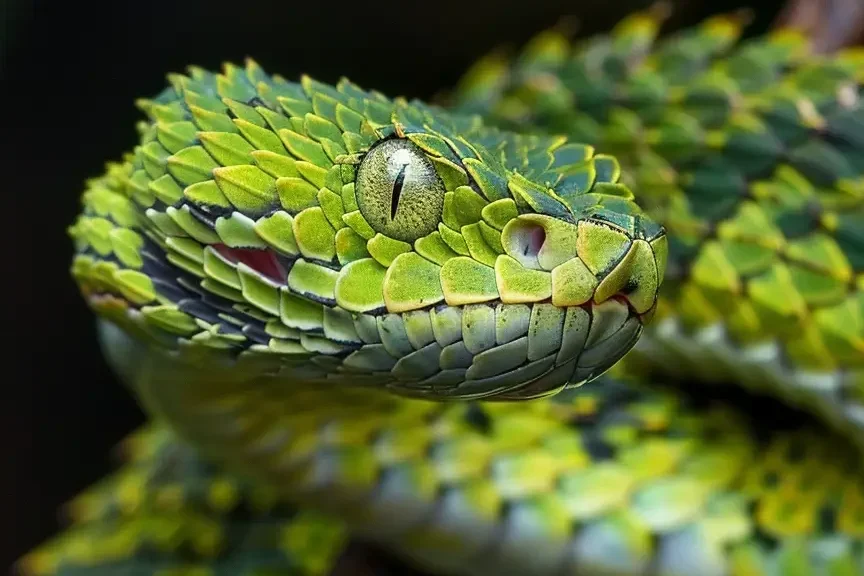
Description of the African Bush Viper’s Physical Appearance:
The African Bush Viper is like a ninja of disguise, perfectly blending into the lush forest. It’s usually around 50 to 70 centimeters long, but some can be even bigger. Its skinny body is covered in special scales that feel rough and help it grab onto branches. These scales aren’t just useful – they also make the viper look like it’s wearing tiny sparkly jewels.
Color Variations:
The African Bush Viper is super cool because it can be all different colors, like bright green or darker green, just like the leaves around it. It’s like it’s playing hide and seek with other animals! This helps it sneak up on food and stay safe from bigger animals that might want to eat it. It’s like it’s wearing a super sneaky invisibility cloak!
Unique Species:
Within the genus Atheris, several unique species of bush vipers exist, each with its own distinct characteristics. Two notable examples are the African Hairy Bush Viper (Atheris hispida) and the Great Lakes Bush Viper (Atheris nitschei).
African Hairy Bush Viper:
The African Hairy Bush Viper earns its name from the tufts of hair-like scales that adorn its body, giving it a somewhat fuzzy appearance. These specialized scales provide additional camouflage and may help regulate the viper’s temperature in its montane forest habitat. Its coloration varies from vibrant green to earthy brown, further enhancing its ability to blend into its surroundings.
Great Lakes Bush Viper:
The Great Lakes Bush Viper lives in the mountains near the African Great Lakes, and it’s totally amazing! Its scales are super cool because they’re all arranged in different shapes, like diamonds or hexagons. Plus, it comes in all sorts of colors, from green to yellow, and sometimes even a little bit of blue or purple. This shows how awesome and diverse its home is, which is why it’s so important to protect the environment where it lives.
Habitat:
The African Bush Viper, scientifically known as Atheris squamigera, thrives in a diverse array of habitats across West and Central Africa. From lush rainforests teeming with life to arid deserts and rocky mountains, these adaptable reptiles have carved out their niche in a multitude of environments.
Distribution:
Their range spans countries such as Nigeria, Cameroon, Ghana, and the Democratic Republic of Congo, where they can be found slithering stealthily amidst the undergrowth.
Adaptation to Various Elevations:
What truly sets the African Bush Viper apart is its remarkable ability to thrive at different elevations. Whether nestled in the dense foliage of lowland rainforests or perched high amidst the rocky outcrops of montane regions, these serpents are masters of adaptation.
Importance of Dense Vegetation:
Dense vegetation serves as more than just a habitat for the African Bush Viper—it’s a lifeline. The intricate patterns and hues of their scales blend seamlessly with the foliage, providing unparalleled camouflage. This allows them to lie in wait, concealed from unsuspecting prey and predators alike.
Nocturnal and Solitary Nature:
As creatures of the night, African Bush Vipers are most active under the cover of darkness. Their solitary disposition makes them elusive denizens of the forest, rarely encountered by human eyes during the day.
Hunting Strategies:
When night falls, these stealthy predators emerge from their hiding spots to hunt. Employing ambush tactics, they patiently await the arrival of prey, striking with lightning speed and precision. Their venomous bite incapacitates their victims, ensuring a swift and efficient kill.
Prey Choices:
The African Bush Viper is an opportunistic feeder, preying on a variety of small mammals, birds, lizards, and even amphibians like toads. Their diverse diet reflects their adaptability and the abundance of prey species in their habitat.
Reproductive Behaviour:
Reproduction among African Bush Vipers is a fascinating process. Females are ovoviviparous, meaning they give birth to live young rather than laying eggs. After a gestation period of several months, the female gives birth to a litter of fully formed neonates, each equipped with the instinctual prowess needed to survive in the wild.
Seasonal Breeding Patterns:
Breeding among African Bush Vipers typically occurs during specific seasons, coinciding with environmental cues such as temperature and rainfall. This ensures optimal conditions for the survival of offspring, setting the stage for the next generation of these mesmerising serpents.
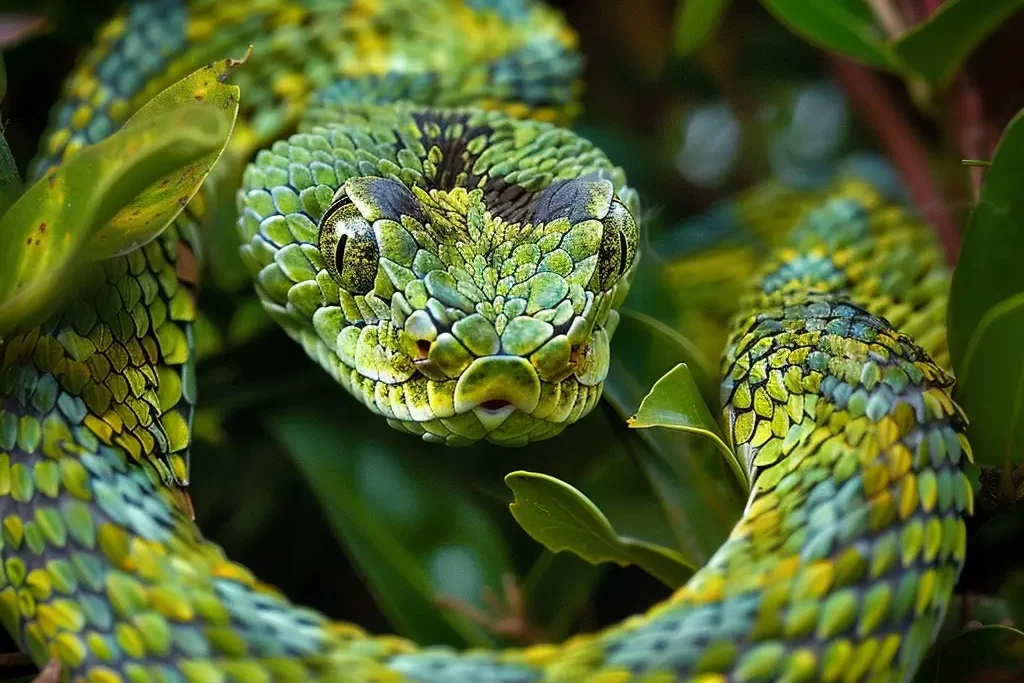
The African Bush Viper, with its vibrant scales and enigmatic presence, stands as a captivating example of nature’s intricacies. One of its most striking features lies in its venom and defense mechanisms, which play a pivotal role in its survival within the wilderness.
Venomous Arsenal:
The venom of the African Bush Viper is super strong! It’s like a powerful potion made of toxins, especially hemotoxins. These toxins attack the blood cells and tissues of whatever it bites, causing lots of damage and making the victim really sick. It’s kinda scary but also really cool how it helps the viper catch food and protect itself from danger.
Effects on Prey and Humans:
When hunting, the viper employs its venom to immobilize small mammals, birds, and even other reptiles. The hemotoxic effects induce hemorrhaging and tissue necrosis, ensuring a swift and efficient kill. However, the same venom poses a significant danger to humans. Without proper medical intervention, a bite from the African Bush Viper can lead to severe tissue damage, organ failure, and even death.
Defensive Behaviors:
The African Bush Viper isn’t mean or looking for trouble. It’s more like a master of staying hidden and staying safe. When it senses danger, it doesn’t go on the attack. Instead, it uses its awesome camouflage skills to blend into its surroundings and waits patiently. If something does try to mess with it, that’s when it strikes super fast to protect itself. It’s like it’s saying, “Leave me alone, and I’ll leave you alone!”
While the African Bush Viper thrives in the wild, its conservation status remains a topic of concern due to various human interactions and environmental factors.
Current Conservation Status:
It’s kinda tricky to figure out exactly how many African Bush Vipers there are and how they’re doing in terms of conservation. They live in really remote places and mostly come out at night, so it’s hard for scientists to study them. Because of this, we don’t have enough information to know for sure how many there are or where they’re all hanging out. This makes it tough to figure out how much help they might need to stay safe in the wild.
Role in Local Ecosystems:
Even though the venom of the African Bush Viper can be really scary, it’s actually super important for the environment where it lives. Since it’s at the top of the food chain, it helps keep the numbers of other animals in check, which helps keep everything balanced. Plus, just by being around, it scares away pests that could cause big problems for plants and other animals. So, even though it might seem scary, the African Bush Viper is actually a big helper in its ecosystem!
Human Interaction and Venom Milking:
People often interact with the African Bush Viper to collect its venom for science and making antivenom. This helps us learn more about how the venom works and how to make medicine to treat bites. But it’s really important that we do this in a way that doesn’t harm the vipers or their homes. We need to make sure we’re not taking too much venom and that we’re protecting the places where they live so they can stick around for a long time.
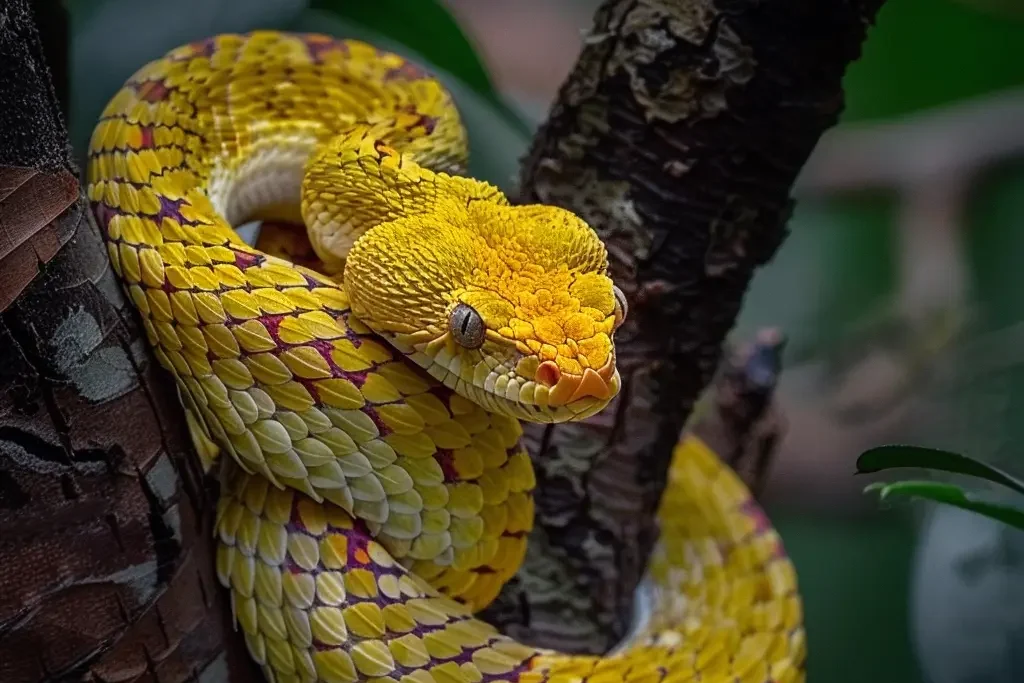
African bush vipers are definitely up there when it comes to dangerous animals. Despite their beautiful looks and sneaky hiding skills, they’ve got some serious venom! How strong it is can change depending on things like how old the snake is, how big it is, and where it lives. But one thing’s for sure – you don’t want to mess with their venom!
Contrary to popular belief, African bush vipers are not inherently aggressive creatures. Instead, they exhibit a cautious and secretive nature, preferring to avoid confrontation whenever possible. However, like any wild animal, they may become defensive if they feel threatened or cornered.
African bush vipers usually don’t go looking for trouble, but if they’re scared or feel trapped, they might bite to defend themselves. Most of the time, people get bitten when they accidentally startle or corner these snakes. So, it’s super important to know that and be really careful when you’re in their home.
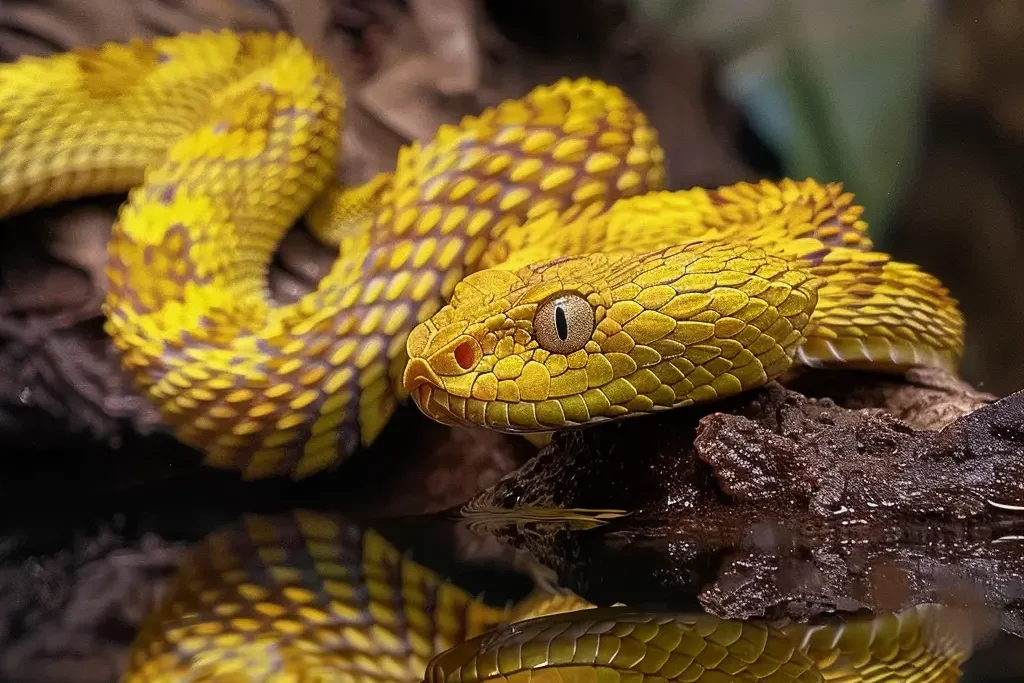
The evolutionary journey of African bush vipers is a fascinating tale of adaptation and survival spanning millions of years. These enigmatic snakes trace their ancestry back to terrestrial ancestors, gradually transitioning to an arboreal lifestyle to exploit new ecological niches.
Despite the inherent dangers associated with their venom, African bush vipers offer valuable insights into the fields of scientific and medical research. Their venomous secretions contain a treasure trove of bioactive compounds with potential applications in drug development, biotechnology, and evolutionary biology.
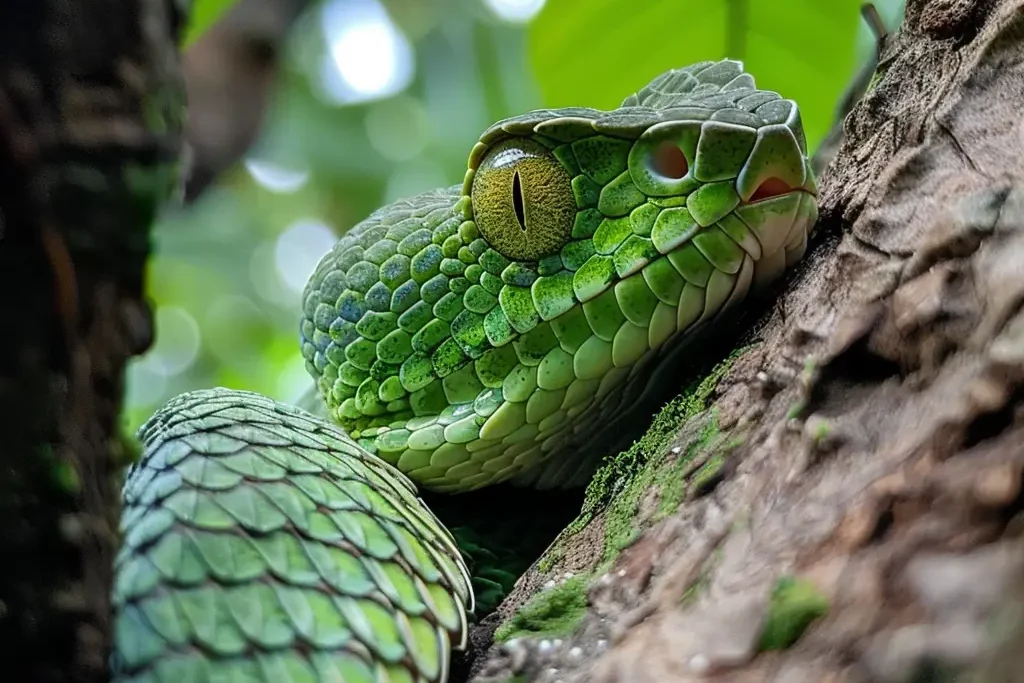
African bush vipers are fascinating creatures that attract a lot of attention because of their stunning looks and mysterious behavior. However, keeping them as pets comes with big responsibilities. It’s important for people who want to have them to make sure they can give them the right care and habitat they need to stay healthy and happy. This means thinking about what’s best for both the snakes and the people taking care of them.
To sum up, the African Bush Viper is a perfect example of Africa’s amazing variety of wildlife. With its ability to blend in and its important job in nature, this mysterious snake shows us how everything in the world is connected.
As people who love wildlife and want to keep it safe, it’s up to all of us to speak up for animals like the African Bush Viper. We need to push for rules that protect them and support more studies to learn more about how they live. Let’s work together to explore and protect their world, so these amazing creatures can keep shining on our planet.
As we’ve explored the African Bush Viper, we’ve learned about where it lives, how it looks, and why it’s important for nature. This journey has helped us see just how amazing and complex life is in Africa’s wild places. It’s clear we need to work hard together to keep all the different plants and animals safe so they can keep on thriving.